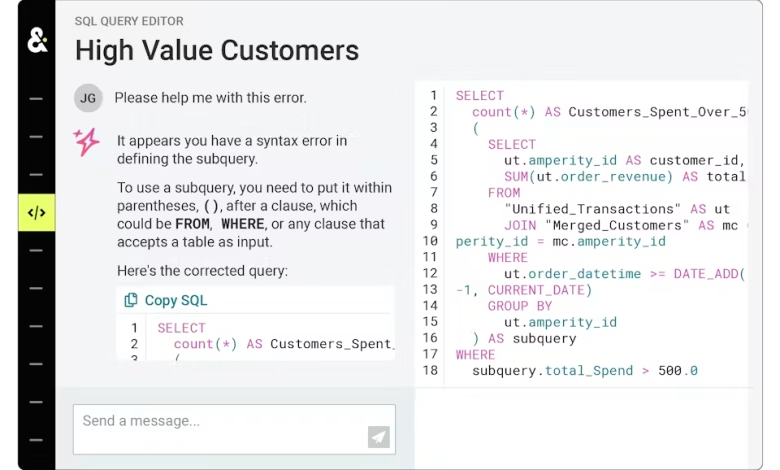
Imagine a world where your brand anticipates customer needs before they’re even expressed. A customer browses winter coats on your mobile app, and by the time they visit your website, they’re greeted with personalized recommendations for matching accessories — with pricing adjusted to their typical spending patterns. This isn’t science fiction; it’s the reality that AI-powered Customer Data Clouds (CDCs) are making possible today.
The rapid advancement of AI is reshaping how brands interact with customers. In our digital-first world, traditional approaches to customer data management simply can’t keep pace. Brands can no longer rely on fragmented systems and basic segmentation tactics — they need intelligent, unified platforms that maximize AI’s capabilities for deeper insights and real-time decision-making.
Fundamentally different from traditional Customer Data Platforms (CDPs), CDCs are leading this transformation. While CDPs primarily focus on data consolidation, CDCs provide real-time analytics, AI-driven automation and seamless system integration across all customer touchpoints. Their cloud-native architecture breaks down data silos, allowing brands to transform raw information into actionable insights to drive one-to-one personalized customer experiences at scale.
The Evolution of Customer Data Management
For years, brands have struggled with fractured customer data, leading to incomplete insights and reactive, rather than proactive, engagement strategies. Instead of building journeys that move customers up the value chain, brands too often find themselves asking reactive questions like why customers may have lapsed. Meanwhile, privacy regulations like GDPR (General Data Protection Regulation) and CCPA (California Consumer Privacy Act) have added layers of operational complexity, requiring stricter governance and compliance measures.
To manage this complexity, brands initially relied on basic rule-based segmentation, grouping customers by predefined characteristics. This approach may have worked yesterday, but fails today as it doesn’t account for individual behaviors in real-time, nor does it adapt to rapidly changing preferences.
AI-powered CDCs have changed the game. These platforms build upon the foundational capabilities of unifying disparate customer data sources to transform insights into action at exactly the right moment. Unlike legacy CDPs, which often require significant integration efforts and force marketers to choose between batch or real-time latencies, CDCs operate natively in the cloud, ensuring immediate data accessibility when and where it’s needed most.
Key AI Trends Reshaping How Brands Use Customer Data
As AI becomes deeply embedded in CDCs, four major trends are transforming customer data strategies:
- Democratized Data Analytics: AI is breaking down the technical barriers to data analysis. Non-technical employees can now generate insights, query data and answer business-critical questions using natural language. This shift doesn’t just speed up decision-making — it fundamentally changes who can participate in data-driven conversations across your organization.
- Predictive AI for Real-Time Decision-Making: The most powerful shift isn’t in understanding what customers did yesterday, but anticipating what they’ll want tomorrow. AI-powered CDCs identify churn risks before customers leave, predict what customers will buy next and deliver personalized recommendations at precisely the right moment. These real-time capabilities allow brands to move from reactive to proactive customer experience strategies that drive measurable results.
- Privacy-First AI Models: Consumer concerns about data privacy aren’t going away — they’re intensifying. Forward-thinking CDCs now integrate privacy-enhancing AI techniques that help companies navigate increasingly strict regulations.
- Agentic Omnichannel Personalization: The customer journey no longer follows a linear path. Modern consumers jump between channels, devices and touchpoints, expecting seamless experiences at every step. AI agents in CDCs automate these omnichannel journeys, ensuring consistent experiences across marketing, sales and service touchpoints.
Navigating the Challenges of AI-Powered Data Strategies
The benefits of AI-powered CDCs are transformative, but implementation isn’t without challenges. Brands that address these head-on will separate themselves from competitors stuck in outdated approaches.
- Balancing Personalization with Customer Experience: While hyper-personalization can drive engagement, overly aggressive AI-driven targeting can feel intrusive or overwhelming to customers. Brands must strike the right balance — delivering relevant, timely experiences without crossing the line into over-personalization or privacy concerns. Transparent opt-in mechanisms and contextual omnichannel personalization strategies that respect customer preferences such as preferred channels can help maintain this balance.
- Evolving Privacy Regulations: Privacy laws continue to evolve rapidly with regulations like GDPR and CCPA setting increasingly rigorous standards. Businesses can’t afford a reactive approach — they must proactively implement privacy-enhancing technologies, regularly update governance policies and maintain transparent consent management.
The brands that address these challenges thoughtfully won’t just mitigate risks — they’ll create competitive advantage, driving customer loyalty and business growth.
AI-Powered CDCs in Action: Real-World Transformations
Across industries, brands are using CDCs to drive measurable improvements in customer experience and business performance:
- Retail & E-Commerce: AI-driven CDCs allow leading retailers to move beyond basic personalization to true one-to-one personalization at scale. Using CDCs, they’re accurately building unified customer profiles, linking duplicate loyalty accounts and delivering “just-right” recommendations that feel intuitive rather than intrusive. One global retailer increased its retention rate by 18% after implementing AI-driven customer reactivation campaigns powered by a CDC.
- Hospitality & Travel: Airlines and hotel chains are using AI-driven CDCs to reinvent the travel experience. By unifying reservation data, loyalty information and real-time sentiment analysis, they’re implementing personalized pricing strategies that optimize both customer satisfaction and revenue. One international hotel group increased ancillary revenue by 24% after implementing personalized upgrade recommendations based on CDC insights.
- Automotive: The automotive industry is leveraging CDCs to transform ownership experiences. Automakers and dealerships now anticipate maintenance needs before breakdowns occur, personalize service recommendations based on driving patterns and send personalized lease-end offers or upgrade suggestions tailored to individual preferences. This data-driven approach strengthens customer relationships, ensuring a seamless and highly personalized journey from purchase to long-term ownership.
Preparing for an AI-Driven Future: Your Strategic Roadmap
The window to gain competitive advantage through AI-powered CDCs is open now, but it won’t remain open indefinitely. Brands that want to lead rather than follow should prioritize these strategic initiatives:
- Align with Business Goals First, Technology Second: Don’t implement CDC technology for its own sake. Companies need to start by defining their core personalization use cases and ensure alignment across departments. A well-coordinated strategy ensures that every data point collected directly supports a brand’s business goals — whether that’s increasing customer lifetime value, reducing acquisition costs or improving retention rates.
- Invest in AI Talent and Infrastructure: The most sophisticated CDC platform won’t deliver results without the right team to leverage it. Brands should foster AI literacy across its organization so insights can be acted upon by teams at every level. Strong leadership, clear mandates and ongoing training will help embed AI-driven decision-making into the company’s DNA.
- Make Customer-Centricity the North Star: AI should enhance — not replace — customer experience strategies. Brands should use technology to deliver genuine value through real-time personalized experiences, maintain transparency in its data collection practices and ensure that AI complements human decision-making rather than substituting for human judgment.
- Start Small, Build Momentum: Don’t wait for perfect conditions to begin. A company should start with its existing tools, run small-scale tests with measurable outcomes iterate quickly based on results — and celebrate early wins. This approach proves value early, secures stakeholder buy-in and allows a brand to refine strategies based on real-world feedback rather than theoretical projections.
The Future Is Already Here
AI-powered CDCs aren’t a distant possibility — they’re the current reality for forward-thinking brands. Those who invest now in unified, intelligent customer data strategies will create personalization and customer experience advantages that latecomers will struggle to overcome.
The future belongs to brands that can anticipate customer needs before they’re expressed, deliver personalized experiences across every touchpoint and maintain trust through responsible data practices. The technology to achieve this exists today through AI-powered CDCs—the question isn’t whether a brand will adapt, but whether it will lead the transformation or be forced to follow those who do.



